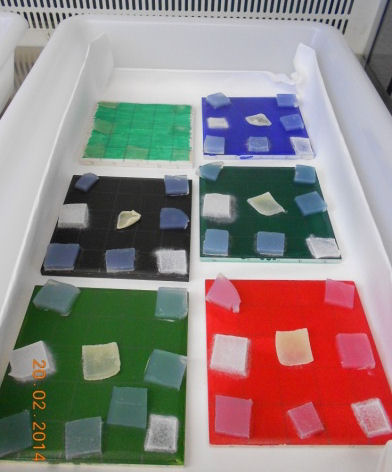|
|
| |
| |
|
Biocleaning of graffiti |
| |
|
Removal of graffiti
is usually performed with mechanical and/or chemical methods.
Recently, alternative methods such as laser cleaning and
biocleaning have been proposed.
In this research we aimed to
formulate new and eco-sustainable methods. In particular, two
types of biocleaning tests were carried out: 1) enzymatic
cleaning with lipase; 2) fungi based cleaning. The first method
was applied on styrene-acrylic pen markers considering that
lipase should be able to hydrolyse the ester bonds of acrylic
polymers. Aqueous systems and oil in water microemulsions
containing different lipases were used: i) a mix of lipases from
bacteria (CTS, Altavilla Vicentina, Italy), ii) lipase from
Candida rugosa and iii) lipase from Candida antarctica. The o/w
microemulsion seemed very promising and its efficiency was
significantly improved when lipases were added. The CTS
commercial product resulted to be effective as well, but mostly
for unaged samples. Moreover, as may be expected, it came out
that the effectiveness of the biocleaning methods seems to
depend on the chemical composition of the paint material to be
removed.
The biocleaning method based on fungi was used for the
removal of alkyd-resin spray paints. In particular, tests were
performed with white-rot fungi (Phanerochaete crysosporium)
known to be able to degrade complex chemical structures such as
lignin. Different culture media were tested and encouraging
results were obtained.
The effectiveness of the cleaning tests
was evaluated by comparing the visible reflectance spectra and
by calculating the colour differences of the test specimens
before and after cleaning. Moreover, an open source software,
IMAGE J, was used to determine the percentage of white in
photographs of the treated areas taken in standard conditions.
This method was proposed for the first time as a new technique
for the evaluation of cleaning tests. |
| |
|
 |
|
Biocleaning tests on
kaolin-pen marker specimens |
| |
|
Published papers
• Germinario G., van der Werf I.D., Montes-Estellés R.M.,
Regidor-Ros J.L., Sabbatini L., Biocleaning of acrylic materials,
Emerge2014, Valencia (Spain), (22-24 September 2014) (extended
abstract )
• Germinario G., van der Werf I.D., Palazzo G., Regidor J.L.,
Montes Estelles R.M., Sabbatini L., Biocleaning of pen markers
paints: the role of lipase, in preparation
• Germinario G., van der Werf I.D., Sabbatini L., Regidor J.L.,
Montes Estelles R.M., Fungi for the cleaning of graffiti : a
preliminary investigation, in preparation |
| |
| |
|
Back to Project
results index |
| |
| |
| |
| |
|
|

